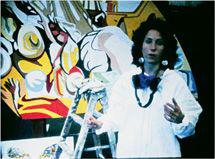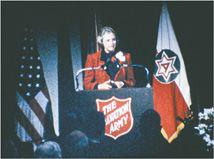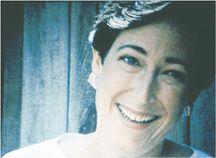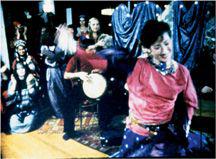B0041VYHGW EBOK (145 page)
Authors: David Bordwell,Kristin Thompson

The next string of interviews reinforces this theme—oddly, by not mentioning gapped teeth at all. The emphasis now falls on women’s activities. A sculptor talks of how her work helps communities
(
10.23
)
; the Indian woman seen earlier draws rice-paint patterns on her threshold; a Hispanic woman trucker describes a long, difficult trip through a storm. The editing contrasts these stories with one, told by Catherine de Santis, about Arab women who remove body hair with a hot-wax concoction—recalling the theme that it can be dangerous to conform to external standards of beauty. More positive instances follow, as a heavy-metal singer explains that she quit her band because of its violent messages, and a gap-toothed woman displays the words “woman” and “peace” painted on her face. A sudden sound bridge plays a dual role here. Over the woman’s face, we hear a chorus singing, “They’ll be marching, marching, marching when the Army comes to town,” as if referring to her antiwar slogans. A cut to a new sequence reveals the music to be diegetic, played by a Salvation Army band before a public speech.

10.23
Gap-Toothed Women
links gaps with creativity.
The speech is given by Supreme Court Justice Sandra Day O’Connor
(
10.24
).
Why is she in the movie? For one thing, she’s gap-toothed. For another, her speech emphasizes “creativity, work, and love” as things that make life worthwhile. Since we’ve just seen several working and creative women, the thematic connection becomes stronger.

10.24 Reportage-style footage of a speech in
Gap-Toothed Women.
O’Connor also says that when creativity is gone, “the will to live seems to go with it.” Her remark leads to the final summarizing segment of the film. In a tight shot, a woman’s stomach gyrates in a belly dance. We glimpse other costumed women looking on and musicians accompanying the dancer. The dancer’s voice-over commentary explains that she is in remission from acute cancer. A cut moves us to a quiet interview with her, identified as Sharyn Sawyer, in everyday clothes against a simple board fence. After facing death, she explains, physical flaws no longer bother her. “You get stepped on by a horse, fine, you know, you’ve got a scar on your leg. Oh, well, you know, you’ve got a gap between your teeth, hey, no problem!” To underscore the comment, the film freezes on her cheerful face
(
10.25
).
Sawyer’s spontaneity and commonsense acceptance of physical flaws and aging help put the anxieties of some of the earlier women in perspective.

10.25
Gap-Toothed Women
freezes the frame after the line “You’ve got a gap between your teeth, hey, no problem.”
Another sound bridge—this time, applause that seems to approve of what Sawyer has said—takes us back to the Middle Eastern dance class, where Sawyer performs another lively dance
(
10.26
).
The credits begin to roll, revealing a very close photo of a smiling gap-toothed mouth, an image that echoes the first shot. A final acknowledgment maintains the film’s exuberant tone: “Many thanks to all the wonderful Gap-Toothed women who made this film possible!”

10.26
Gap-Toothed Women
’s leukemia survivor leaps and spins to the applause of musicians and onlookers.
Gap-Toothed Women
shows that category-based form need not be a dry recitation of conceptual similarities and differences. A documentary using this organization can take a stance on its subject, play among contrasting attitudes, and entertain an audience. Blank and his collaborators have created a light, often humorous, film in part by choosing an unusual category and in part by the way they use film technique to present it.
Such a film can also create the four levels of meaning that we described in
Chapter 2
(
pp. 62
–65). On the referential level,
Gap-Toothed Women
simply presents a series of gap-toothed women from different races and different cultural and class backgrounds. We may know some of their faces and names from previous experience (Madonna and Whoopi Goldberg most obviously, Claudia Schmidt and Dori Seda to fans of folk music and underground comics). We also know that
Vogue
is a fashion magazine and assume that the magazines with Russian or other foreign writing are those countries’ equivalents of
Vogue.
Moving to the level of explicit meaning, the interviewees display a range of reactions to gap-teeth. Some are obviously proud, some embarrassed, others more ambivalent. Some express quite directly the idea that magazines and other people often stigmatize people with gaps, while others reveal that gaps are admired in some cultures. At one point, the sculptor compares the lack of gap-toothed models in magazines to the notion of black people seeing only white faces in media images. This explicitly links stereotyped attitudes about feminine beauty to racism. In most cases, the filmmakers’ voices are not heard; they let their interviewees make these points.
The film’s form is not organized as an argument in favor of gap-teeth being a natural, even attractive, trait; yet on the level of implicit meaning, the music and photographs of smiling, gap-toothed women tend to suggest just that. The choice of some very beautiful women who are worried about their gaps cues us to interpret their fears as unnecessary. Certain women’s comments are clearly privileged as reflecting the ideas that the filmmakers wish to convey. Dori Seda’s discussion of how important it is for women to do things helps define the film’s segment on careers and creativity, and the cancer survivor’s speech at the end makes anxieties about gapped teeth trivial in relation to the potential joys of life.
Beyond these three levels of meaning, we can also discern symptomatic meanings. Blank began making films in the 1960s, a period when a counterculture based upon protest and distrust of authority emerged. More specifically, it was the era of women’s liberation, with its demands for gender equality and the breaking down of feminine stereotypes. By 1987, when the film appeared, the counterculture of the 1960s and 1970s had died down, but many people preserved its ideals. Several of the women interviewed in Blank’s film are clearly of this generation and sensibility. Moreover, one legacy of the counterculture has been widespread attention paid to society’s pressures on women to conform to limiting ideals of beauty.
Gap-Toothed Women
could be interpreted as reflecting the shift of some radical attitudes of the 1960s into the mainstream—a situation that persists and makes Blank’s 1987 film still relevant today.
Another type of documentary film uses
rhetorical
form, in which the filmmaker presents a persuasive argument. The goal in such a film is to persuade the audience to adopt an opinion about the subject matter and perhaps to act on that opinion. This type of film goes beyond the categorical type in that it tries to make an explicit argument.
Rhetorical form is common in all the media. We encounter it frequently in daily life, not just in formal speeches but also in conversation. People often try to persuade each other by argument. Salespeople use persuasion in their jobs, and friends may argue politics over lunch. Television bombards us with one of the most pervasive uses of rhetorical form in film—commercials, which try to induce viewers to buy products or vote for candidates.
We can define rhetorical form in film by four basic attributes. First, it addresses the viewer openly, trying to move him or her to a new intellectual conviction, to a new emotional attitude, or to action. (In the latter case, we may already believe something but need to be persuaded that the belief is important enough to act upon.)
Second, the subject of the film is usually not an issue of scientific truth but a matter of opinion, toward which a person may take a number of equally plausible attitudes. The filmmaker tries to make his or her position seem the most plausible by presenting different types of arguments and evidence. Yet, because the issue cannot be absolutely proved, we may accept the position simply because the film-maker has made a convincing case for it. Because rhetorical films deal with beliefs and arguments, they involve the expression of ideology; indeed, perhaps no type of film form centers so consistently on explicit meaning and ideological implications.
A third aspect of rhetorical form follows from this. If the conclusion cannot be proved beyond question, the filmmaker often appeals to our emotions, rather than presenting only factual evidence. And fourth, the film often attempts to persuade the viewer to make a choice that will have an effect on his or her everyday life. This may be as simple as what shampoo to use, or it may involve decisions about which political candidate to support or even whether a young person will fight in a war.
Films can use all sorts of arguments to persuade us to make such choices. Often, however, these arguments are not presented to us
as
arguments. The film frequently presents arguments as if they were simply observations or factual conclusions. Nor does the film tend to point out other opinions. There are three main types of arguments the film may use: relating to the source, to the subject, and to the viewer.
Some of the film’s arguments will rely on what are taken to be reliable sources of information. The film may present firsthand accounts of events, expert testimony at a hearing, or interviews with people assumed to be knowledgeable on the subject. Most political documentaries include talking-head footage of investigators, scholars, or insiders. At the same time, the filmmakers will try to show that they themselves are well informed and trustworthy. They may insert themselves into the interview situation, as Michael Moore does in his documentaries, or they may use a voice-over narrator speaking in tones of crisp conviction.
